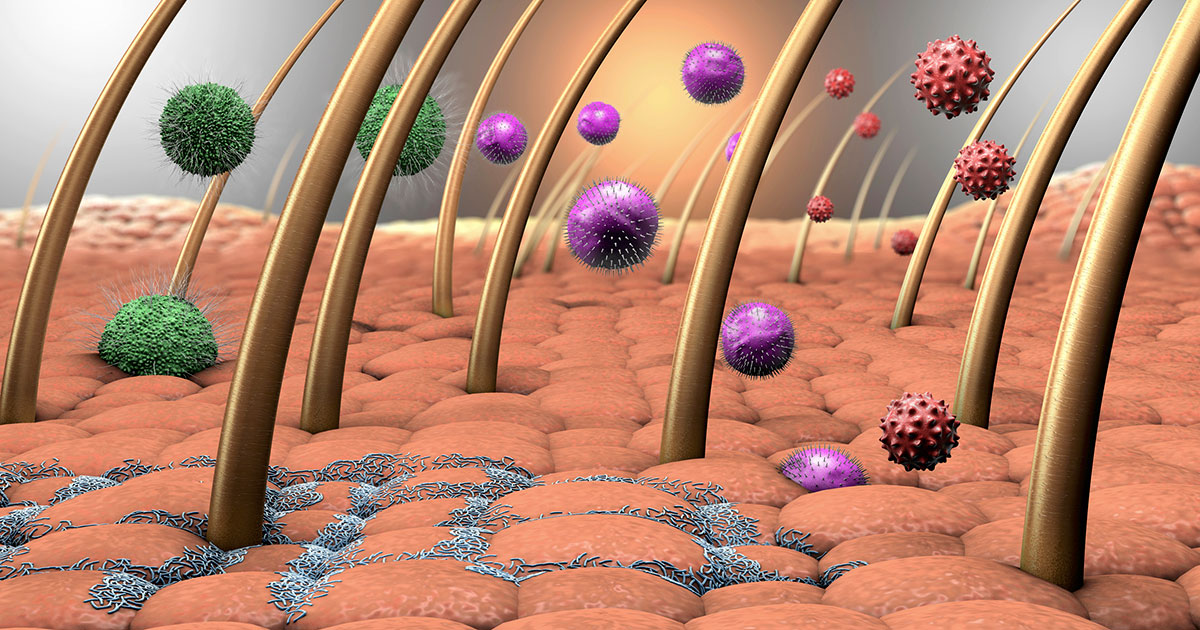
Of all the organs in the human body, few take the pounding your skin does. Yes, your skin is an organ, your body’s largest, in fact, and among your most important, considering you cannot live without it.
Your skin is a biological marvel capable of performing remarkable functions every day. It protects your muscles and organs from outside threats. It endures bumps and bruises, cuts and scratches, the sun’s burning rays and the grime left by dirt and dust. It moves and stretches when you do and mostly bounces back to form when you’re still.
Even when your body is at rest, your skin is a bustle of cellular activity. Basal cells change shape as they move to the surface to replace dying squamous cells. Merkel cells help your nerves sense the touch of another. Melanocytes produce melanin, the skin-darkening pigment that protects your skin from the sun.
And like other organs, your skin may develop cancer. Skin cancer is the most common cancer in the United States, with more than 3 million people diagnosed each year.
Treatments and prognoses vary greatly, depending on the affected cells and type of skin cancer diagnosed. While squamous cell or basal cell carcinomas are often localized and highly treatable, Merkel cell cancer and melanoma are very serious and even life threatening.
“I think people regard melanoma as a very serious diagnosis,” says David Winchester, MD, Surgical Oncologist at City of Hope Chicago and Gurnee. “When I talk to a lay person about skin cancer, they frequently reference melanoma and that it can be a deadly disease.”
The recent death of singer-songwriter Jimmy Buffet from Merkel cell carcinoma has thrust that rarely discussed and lethal cancer into the forefront.
In this article, we’ll the different types of cells in the skin and their associated cancers. Topics include:
- Basal cells
- Squamous cells
- Merkel cells
- Melanocytes
- The ABCDE rule of skin cancer
- How to prevent skin cells from becoming cancerous
If you’ve been diagnosed with melanoma and are interested in a second opinion on your diagnosis or treatment options, call us or chat online with a member of our team.
Basal cells
Most of the cells found in our skin are basal cells, also called keratinocytes. These round cells form at the bottom of the epidermis and flatten as they make their way to the surface, transforming into squamous cells.
Basal cell carcinomas account for nearly 75 percent of all skin cancers, according to the American Cancer Society. This type of cancer grows very slowly and rarely metastasizes or spreads to distant organs.
Squamous cells
Most of the cells on the skin's surface are flat, scale-like squamous cells. Unlike basal cells, squamous cells are found in other parts of the body, including the lips, throat, the linings of the respiratory and digestive systems and the cervix.
Squamous cell carcinomas are the second most common type of skin cancer, accounting for about 20 percent of all diagnoses. These cancers also are slowing growing, but squamous cell carcinomas can spread to lymph nodes and even internal organs. Research indicates that the metastasis rate of squamous cell carcinoma of the skin is less than 10 percent within two years of diagnosis.
Basal cell and squamous cell skin cancer cells grow slowly are rarely fatal but may cause serious complications or require disfiguring surgery if left untreated.
They both often appear as growths, bumps or sores that don't go away. And they tend to show up on sun-exposed areas—the head, legs and arms.
Merkel cells
More than 150 years ago, a German scientists named Friedrich Merkel documented what he identified as tastzellen, German for “touch cells.” They would later be named Merkel cells. These cells are found below the epidermis, where they interact with nerve cells and help the skin feel light touch, textures and fine details.
Merkel cell carcinomas may appear as bumps or nodules—often red in color—on sun-exposed skin. This is a rare cancer, but it is often aggressive and may metastasize.
"Sun exposure is a very significant risk factor,” Dr. Winchester says. “But a virus also has been linked as a risk factor as well.”
About 2,000 to 3,000 cases of Merkel cell carcinoma are diagnosed in the United States every year, according to the American Cancer Society, and the numbers are on the rise. The disease is rarely diagnosed in patients under 50 years old and is mostly found in white men older than 70.
Buffet was 76 when he passed away. Not much is publicly known about Buffet’s specific diagnosis or treatment plan. He was diagnosed four years before his passing and performed in public just two months before his death. The Merkel cell polyomavirus is a member of the Polyomaviridae family of viruses commonly found on mammals.
The Merkel cell polyomavirus was discovered in 2008. It is believed these viruses may be contracted when we are young and we may carry dormant versions of these viruses with us our whole lives. Age, sun exposure, a weakened immune system and other factors may re-activate the virus. The mechanisms of how these viruses interact with Merkel cells and may lead to cancer are not fully understood.
First-line treatment for the disease is surgery. Immune checkpoint inhibitors—a type of immunotherapy—may also be used to treat specific cases of metastatic Merkel cell carcinoma.
Melanocytes
When we are exposed to the sun, our melanocytes are summoned into action. They produce a substance called melanin, which protects our skin from UV light. And it also tans our skin.
But at some point, the melanin alone can’t help, so we rely on sunscreen to protect us from damaging UV rays. With or without protection, however, melanocytes can become damaged and begin to grow out of control. The result is melanoma, an extremely aggressive and most deadly form of skin cancer.
Only 2 percent of all skin cancers are melanomas, but they account for most skin-cancer deaths. Even tiny melanoma tumors can spread to your lymph nodes and grow quickly throughout your body. And, even after tumors are removed by surgery, the cancer has a high rate of recurrence.
Melanomas are often caused by UV exposure, but it may also grow in areas not exposed to the sun, such as under the feet or under fingernails. And a rare form of melanoma—called ocular melanoma—may also be found in the eyes.
Melanoma is often treated with surgery and immunotherapy if it has spread to other parts of the body. Former President Jimmy Carter was treated with immunotherapy after doctors found melanoma lesions on his brain and in his lungs. That was in 2015. Carter turned 99 on Oct. 1 and is now in hospice care.
The ABCDE rule of skin cancer
It may be difficult to determine whether a mole, bump or sore has developed into cancer, or which type of cancer. Using the ABCDE test, detailed below, may help evaluate whether an abnormal growth may be melanoma.
A is for asymmetry: Does the mole have an irregular shape?
B is for border: Is it rough or notched around the edges?
C is for color: It is changing shade or color?
D is for diameter: Is it larger than the size of a pencil eraser?
E is for evolution or elevation: Is the spot growing in height or width?
If a mole is changing, if the border is irregular or if it is getting crusty or bleeding, you should have your doctor or a dermatologist look it over.
How to prevent skin cells from becoming cancerous
Family history, age and immune-system deficiencies are among several factors that may raise your risk of skin cancer. But the primary cause is exposure to ultraviolet light.
Some tips that may help you reduce your risk, even if you want to stay active outside, are listed below.
Use sunscreen: Find waterproof sunscreen with an SPF (sun protection factor) of 30 or higher. Reapply regularly, if you are outside for long periods, are sweating or go for a swim.
Seek shade: look for shady spots to settle outside, if you can, especially if you are out between 10 a.m. and 4 p.m., when the sun is the strongest.
Cover up: Wear a wide-brimmed hat, UV-blocking sunglasses and long sleeves and pants. Look for hats, glasses and clothing with ultraviolet protection factor (UPF) numbers on the label.
Don't burn: Avoid sunburn, and make sure your children are protected from burns. Sunburns may increase the risk of melanoma.
Avoid tanning salons: Booths and beds use damaging ultraviolet light.
Get checked: Examine your skin for suspicious spots every month and see a dermatologist for a full-body skin check once a year. The American Academy of Dermatology provides a body map to help you keep a record of suspicious spots.
If you’ve been diagnosed with melanoma and are interested in a second opinion on your diagnosis or treatment options, call us or chat online with a member of our team.



